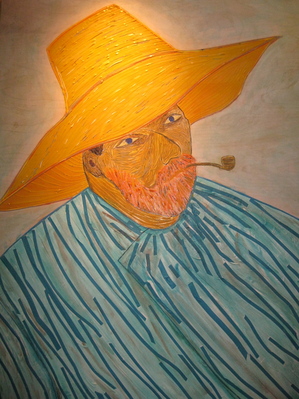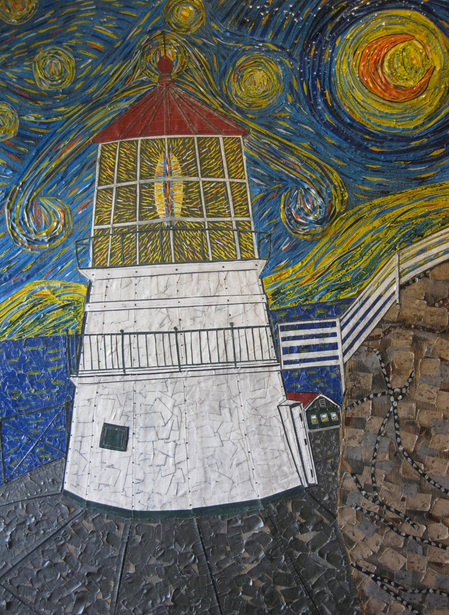Duct-tape art salutes and expands on the work of van Gogh

"Vincent-Arles-1888"
The allure of Vincent van Gogh for today’s artists is his explosive iconoclasm, so it's not surprising that he would inspire an artist like Warburton.
A former Chelsea Beach Middle School counselor, Warburton’s surrendered himself to his unconventional art form through this last decade and is now making a keen go of it as a professional artist. His work is in the collections of the Vatican, Nice’s National Art Museum, and the personal studio of Jamie Wythe. This exhibit is one of three concurrent Warburton duct tape exhibits at Biggby outlets; the others are on West Stadium and in Saline.
As his gallery statement tells us, Warburton recognizes that “duct tape falls into the category of ‘outsider’ art.” And given that Vincent van Gogh is the ultimate outsider in art, it’s appropriate that Warburton concludes this statement by saying that “he takes his inspiration from, well—whatever.”
It’s sometimes forgotten that Van Gogh, too, articulated his passion through the unusual use of his medium. His use of thickly textured oils (that makes no attempt to look remotely refined in their application) was as revolutionary in his time as the use of duct tape is today.
In Van Gogh's hands, post-impressionist impasto (the application of thickened oils) becomes the reason for the composition. Thus while we still marvel today about the vivacity of his achievement, the farthest-reaching aspect of his art has ironically become a commonplace tool.
Whether deliberately or accidently, Warburton’s work peels back van Gogh’s fame to remind us of what is likely his greatest achievement: reorienting the practice of painting at its very root.
And what better way than to use an “outsider” medium whose very use breaks through standard practice with every application? Warburton extends the use of his duct tape by applying it in a quasi-pointillist manner. Initially tapering his duct tape in broad rectilinear grids; then contrasting this application with exceedingly intricate smaller patches, he modulates his expression to suit his temperament in the way an expressionist painter modifies his brushstroke.
This is most clearly seen in a painting like Warburton’s reinterpretation of van Gogh’s famed 1886 “Le Moulin de la Galette,” in which he patterns the work’s appearance on the van Gogh original, but also takes the liberty of not following van Gogh all that closely.
The famed windmill remains the same. Yet van Gogh’s foreground figure has been eliminated; Warburton uses van Gogh as a jumping off point for his own expression.
Warburton’s duct tape has a similar visual solidity as impasto; but it’s far less malleable, so he carves his working surface as an extension of his creativity. As a result, Warburton crafts an homage that steps beyond its original source with an extraordinary sensitivity.

"Starry Night Pt. Reyes"
The van Gogh 1879 “Starry Night” speaks volumes for itself—there are few more famous paintings in the history of art. But Warburton’s “Starry Night—Pt. Reyes” also speaks for itself.
The hundreds of duct tape cuts crafting this surprisingly intricate composition merely reflect Warburton’s respect. The original’s vitality informs this latter-day interpretation.
Warburton’s “whatever” takes his art wherever he chooses, while his exceptional medium also liberates his creativity. “Starry Night—Pt. Reyes” therefore isn’t a mere appropriation as much as it’s a reinvigoration of what it means to be an artist. Such a stance only requires a strong enough temperament to be willing to work on the fringe of accepted convention—just as once did Vincent van Gogh.
“Van Gogh Duct Tape Art” will continue through June 7 at Biggby Coffee, 1741 Plymouth Road. Exhibit hours are 6 a.m. to 9 p.m., Monday-Friday; and 7 to 9 p.m., Saturday-Sunday. For information, call 734-222-7030. Other Warburton duct tape exhibits are at Biggby outlets at 1741 Plymouth Road in Ann Arbor and 6961 E. Michigan Ave. in Saline.

